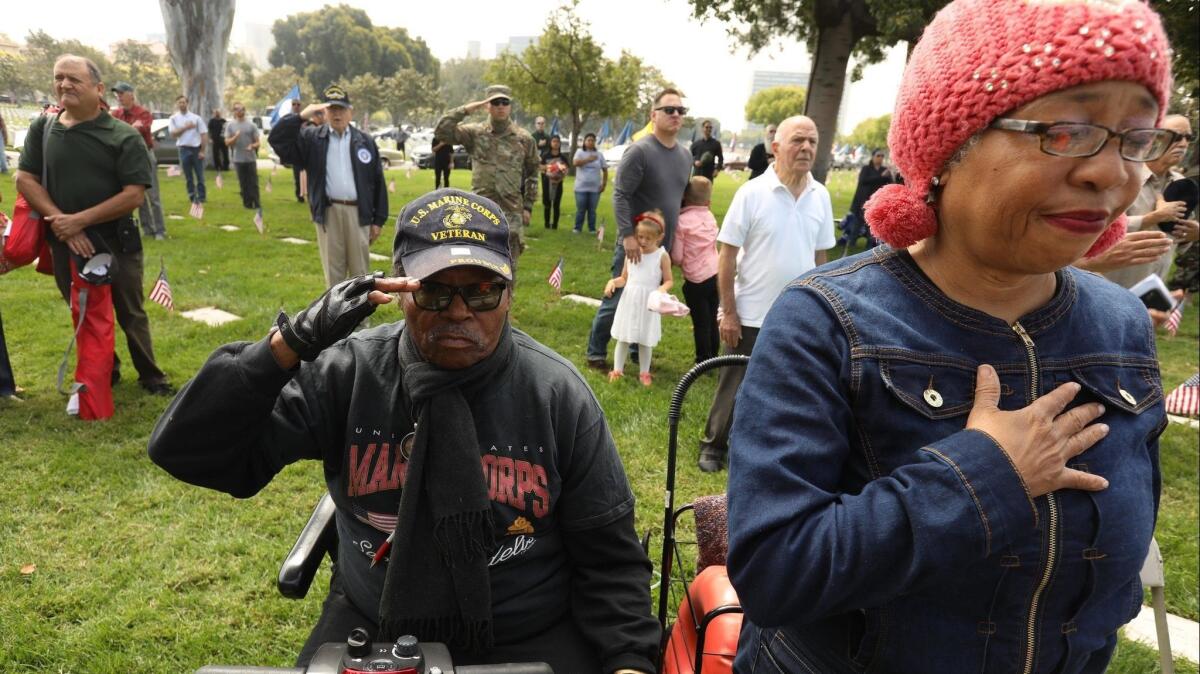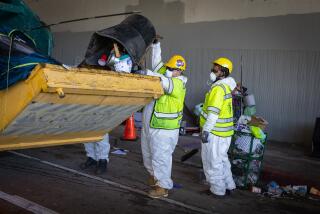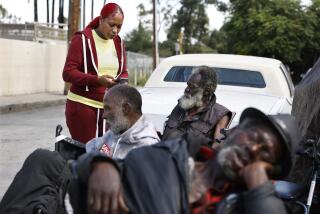Editorial: This Memorial Day, let’s make sure L.A.’s veterans don’t die homeless

Outside the eastern edge of the campus of the U.S. Department of Veteran Affairs in West Los Angeles lie the interred remains of veterans who served their country. A couple of days before Memorial Day each year, Scouts place flags on each grave.
Just outside the opposite edge of the VA campus sits a homeless encampment. Its population ebbs and flows from day to day, but most of the time there are people living on the sidewalk in lean-tos ingeniously fashioned out of tarps and shopping carts, using the iron rails of the VA’s fence as a back wall, draped with towels and sheets. On a recent night, a man sat nestled in an upholstered easy chair, reading a book in the dark.
As encampments go, it’s relatively small — 10 people sometimes, two dozen at other times. On any given day, a little less than half are veterans. Outreach workers from the VA and nonprofit groups constantly interact with the group, and VA officials say they have been able to house about 40% of the veterans who have come through the encampment. Some have been persuaded to come into the campus Welcome Center for a shower, a snack or an overnight shelter bed. According to one advocate for homeless people, most have already been connected to service providers, and some just want a bus ticket back to a family home, wherever that may be.
Homeless veterans desperately need housing, just like the rest of the homeless population in L.A. County.
But as people leave the encampment, others come in to claim spots on the sidewalk. It’s a reminder that even as the county has housed a few thousand veterans each year for the last several years, another few thousand have taken their places on the rolls of homeless veterans. The number of homeless veterans in Los Angeles county went down from about 4,800 in 2017 to roughly 3,900, according to the 2018 homeless count. But that number is not expected to change much when the results of the 2019 homeless count are announced next month.
VA officials say that some of the homeless veterans they approach outside their gates suffer from mental illness or addictions that keep them from staying housed. No doubt that’s true for a portion of all the homeless veterans in the county (and elsewhere), but such problems alone can’t explain why the number of homeless veterans here has barely budged in the last year.
Meanwhile, homeless veterans desperately need housing, just like the rest of the homeless population in the county. As part of a 2015 court settlement with homeless veterans in L.A. County, the VA agreed to revamp its 388-acre campus and open 1,200 housing units for chronically homeless vets. The draft master plan the VA created is ambitious and creative, but implementing it has been maddeningly time-consuming, freighted with all the bureaucracy of redeveloping a small town. So far, only one building offering permanent housing is open, serving fewer than 60 veterans who were homeless.
A planned 100-bed shelter on the West L.A. campus for vets waiting for permanent housing — part of Los Angeles Mayor Eric Garcetti’s “A Bridge Home” program — hit a snag when an underground asbestos-laden sewer pipe was discovered. Now, the shelter isn’t expected to open until October. (A number of the bridge shelters around the city have encountered similar problems.) Ideally, some of the veterans on the sidewalk could move into that bridge shelter.
Enter the Fray: First takes on the news of the minute »
Tellingly, one of the most successful homeless housing programs on the VA campus right now doesn’t provide any actual housing. It’s the safe parking program that the nonprofit Safe Parking L.A. runs, giving homeless veterans who live in their cars a protected place to park overnight. More than 30 spaces are generally occupied, and there are plans to increase the number to 50.
One promising development: The environmental impact study that the VA was required to do as part of its master plan will be completed and released next month, allowing the agency to start the process of leasing land to developers to build on the grounds.
All these efforts need to go faster. The longer it takes to build permanent supportive housing on the VA campus or set up the bridge shelter, the more those homeless veterans on the western edge of the campus are in danger of becoming casualties buried on the eastern side.
Follow the Opinion section on Twitter @latimesopinion or Facebook.
More to Read
A cure for the common opinion
Get thought-provoking perspectives with our weekly newsletter.
You may occasionally receive promotional content from the Los Angeles Times.






